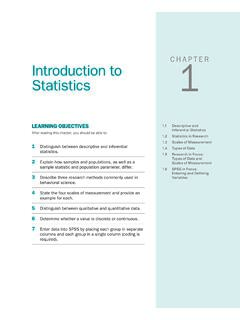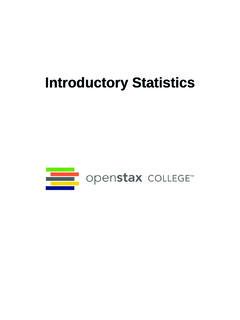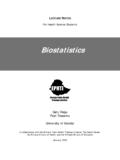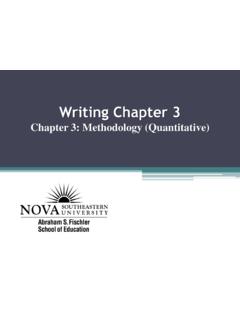Transcription of Introduction to Probability and Statistics for Engineers ...
1 Introduction TOPROBABILITY AND STATISTICSFOR Engineers AND SCIENTISTST hird EditionLIMITED WARRANTY AND DISCLAIMER OF LIABILITYA cademic Press, ( AP ) and anyone else who has been involved in the creation or produc-tion of the accompanying code ( the product ) cannot and do not warrant the performanceor results that may be obtained by using the product. The product is sold as is withoutwarranty of merchantability or fitness for any particular purpose. AP warrants only thatthe magnetic diskette(s) on which the code is recorded is free from defects in material andfaulty workmanship under the normal use and service for a period of ninety (90) daysfrom the date the product is delivered. The purchaser s sole and exclusive remedy in theevent of a defect is expressly limited to either replacement of the diskette(s) or refund ofthe purchase price, at AP s sole no event, whether as a result of breach of contract, warranty, or tort (includingnegligence)
2 , will AP or anyone who has been involved in the creation or production ofthe product be liable to purchaser for any damages, including any lost profits, lost savings,or other incidental or consequential damages arising out of the use or inability to use theproduct or any modifications thereof, or due to the contents of the code, even if AP hasbeen advised on the possibility of such damages, or for any claim by any other request for replacement of a defective diskette must be postage prepaid and mustbe accompanied by the original defective diskette, your mailing address and telephonenumber, and proof of date of purchase and purchase price. Send such requests, statingthe nature of the problem, to Academic Press Customer Service, 6277 Sea Harbor Drive,Orlando, FL 32887, 1-800-321-5068.
3 AP shall have no obligation to refund the purchaseprice or to replace a diskette based on claims of defects in the nature or operation of states do not allow limitation on how long an implied warranty lasts, nor exclu-sions or limitations of incidental or consequential damage, so the above limitations andexclusions may not apply to you. This warranty gives you specific legal rights, and youmay also have other rights, which vary from jurisdiction to re-export of United States original software is subject to the United States lawsunder the Export Administration Act of 1969 as amended. Any further sale of the productshall be in compliance with the United States Department of Commerce Administra-tion regulations. Compliance with such regulations is your responsibility and not theresponsibility of TOPROBABILITY AND STATISTICSFOR Engineers AND SCIENTISTS Third Edition Sheldon M.
4 RossDepartment of Industrial Engineering and Operations ResearchUniversity of California, BerkeleyAmsterdam Boston Heidelberg London New York OxfordParis San Diego San Francisco Singapore Sydney TokyoElsevier Academic Press200 Wheeler Road, 6thFloor, Burlington, MA 01803, USA525 B Street, Suite 1900, San Diego, California 92101-4495, USA84 Theobald s Road, London WC1X 8RR, UKThis book is printed on acid-free 2004, Elsevier Inc. All rights part of this publication may be reproduced or transmitted in any form or by anymeans, electronic or mechanical, including photocopy, recording, or any informationstorage and retrieval system, without permission in writing from the may be sought directly from Elsevier s Science & Technology Rights Department inOxford, UK: phone: (+44) 1865 843830, fax: (+44) 1865 853333, e-mail: may also complete your request on-line via the Elsevier homepage ( ), by selecting Customer Support and then Obtaining Permissions.
5 Library of Congress Cataloging-in-Publication DataApplication submittedBritish Library Cataloguing in Publication DataA catalogue record for this book is available from the British LibraryISBN: 0-12-598057-4 (Text)ISBN: 0-12-598059-0 (CD-ROM)For all information on all Academic Press publicationsvisit our Web site at in the United States of America040506070809 1 Introduction to Collection and descriptive Statistics and Probability and Brief History of 7 chapter 2 descriptive Data Tables and Frequency Tables and Data, Histograms, Ogives, and Stem and Leaf Data Mean, Sample Median, and Sample Variance and Sample Standard Percentiles and Box s Data Data Sets and the Sample Correlation 41 chapter 3 Elements of Space and Diagrams and the Algebra of of Spaces Having Equally Likely 80 chapter 4 Random Variables and of Random Distributed Random Random 101* of the Expected Value of Sums of Random and Variance of Sums of Random Generating s Inequality and the Weak Law of Large 130 chapter 5 Special Random Bernoulli and Binomial Random the Binomial Distribution Poisson Random the Poisson Distribution Hypergeometric Random Uniform Random Random
6 Random 175* Poisson 179* Gamma Arising from the Chi-Square 185* Relation Between Chi-Square and Gamma 191* Logistics 194 chapter 6 Distributions of Sampling Sample Central Limit Distribution of the Sample Large a Sample is Needed?.. Sample Distributions from a Normal of the Sample Distribution from a Finite 221 chapter 7 Parameter Likelihood 230* Life Interval for a Normal Mean When the Variance Intervals for the Variances of a Normal the Difference in Means of Two Normal Confidence Interval for the Mean of a BernoulliRandom 260* Interval of the Mean of the Exponential 265* a Point 266* Bayes 277 chapter 8 Hypothesis Concerning the Mean of a Normal of Known of Unknown Variance.
7 The Equality of Means of Two Normal of Known of Unknown of Unknown and Unequal Tests Concerning the Variance of a Normal for the Equality of Variances of Two Tests in Bernoulli the Equality of Parameters in Two Concerning the Mean of a Poisson the Relationship Between Two Poisson 334 chapter Squares Estimators of the Regression of the Inferences about the Regression Concerning .. to the Concerning .. Concerning the Mean Response + Interval of a Future of Distributional Coefficient of Determination and the Sample of Residuals: Assessing the to Least 391* Linear Future Regression Models for Binary Output 413 chapter 10 Analysis of Analysis of Comparisons of Sample Analysis of Variance with Unequal Sample Analysis of Variance: Introduction and Analysis of Variance.
8 Testing Analysis of Variance with 471 chapter 11 Goodness of Fit Tests and Categorical Data of Fit Tests When all Parameters are the Critical Region by of Fit Tests When Some Parameters are of Independence in Contingency of Independence in Contingency Tables Having FixedMarginal 499* Kolmogorov Smirnov Goodness of Fit Test for 508 chapter 12 Nonparametric Hypothesis Sign Signed Rank Two-Sample Classical Approximation and Runs Test for 537 chapter 13 Quality Charts for Average Values: TheX-Control of Unknown and .. Charts for the Fraction Charts for Number of Control Charts for Detecting Changes in the Control Weighted Moving-Average Control Sum Control 573 chapter 14*Life Rate Exponential Distribution in Life Testing Stopping at therth Testing Stopping by a Fixed Bayesian Two-Sample Weibull Distribution in Life Estimation by Least 604 Appendix of 617* Denotes optional third edition of this book continues to demonstrate how to apply Probability theoryto gain insight into real, everyday statistical problems and situations.
9 As in the previouseditions, carefully developed coverage of Probability motivates probabilistic models of realphenomena and the statistical procedures that follow. This approach ultimately resultsin an intuitive understanding of statistical procedures and strategies most often used bypracticing Engineers and book has been written for an introductory course in Statistics , or in probabilityand Statistics , for students in engineering, computer science, mathematics, Statistics , andthe natural sciences. As such it assumes knowledge of elementary AND COVERAGEC hapter 1presents a brief Introduction to Statistics , presenting its two branches of descrip-tive and inferential Statistics , and a short history of the subject and some of the peoplewhose early work provided a foundation for work done subject matter of descriptive Statistics is then considered inChapter andtables that describe a data set are presented in this chapter , as are quantities that are usedto summarize certain of the key properties of the data be able to draw conclusions from data, it is necessary to have an understandingof the data s origination.
10 For instance, it is often assumed that the data constitute a random sample from some population. To understand exactly what this means andwhat its consequences are for relating properties of the sample data to properties of theentire population, it is necessary to have some understanding of Probability , and thatis the subject ofChapter 3. This chapter introduces the idea of a Probability experi-ment, explains the concept of the Probability of an event, and presents the axioms study of Probability is continued inChapter 4, which deals with the importantconcepts of random variables and expectation, and inChapter 5,which considers somespecial types of random variables that often occur in applications. Such random variablesas the binomial, Poisson, hypergeometric, normal, uniform, gamma, chi-square,t, andFare 6, we study the Probability distribution of such sampling statisticsas the sample mean and the sample variance.









